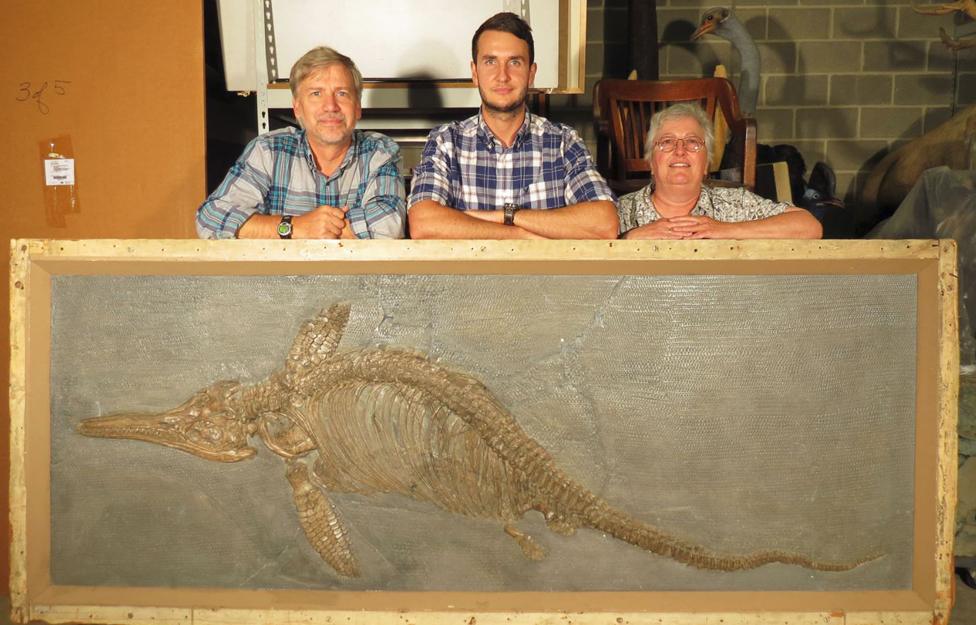British 'sea dragon' fossils are 'new to science'
- Published

Palaeontologists Dean Lomax (centre) and Judy Massare (right) with one the fossils
Scientific detective work on fossils collected in Victorian times has identified two new species of Ichthyosaurs - the giant reptiles that swam at the time of the dinosaurs.
It brings to six the known species of Ichthyosaurus - ''sea dragons'' that ruled the oceans in Jurassic times.
Both fossils were unearthed in Somerset in the 1800s.
One specimen has been on display at Bristol University for decades, under the gaze of countless students.
The other was donated to a museum in Philadelphia, US, by Thomas Hawkins, a well-known Victorian fossil collector.
He amassed a huge collection of marine reptiles from Somerset in the first half of the 19th Century.
Such was the Victorian craze for skeletons of ichythyosaurs - the first was found by Mary Anning on the Dorset coast - that they ended up in museums and collections right across the world.
Palaeontologists Dean Lomax of Manchester University and Judy Massare of Brockport College, New York, examined hundreds of ichthyosaur fossils in Europe and North America, including some that had been kept hidden for decades.
''These are two new species - brand new species to science,'' Dean Lomax told 91»»±¨ News.
''They show that during the early Jurassic - around 200 million years ago - the ichythyosaur, and specifically this particular type, was a lot more diverse than previously thought.''
The Bristol specimen has been named Ichthyosaurus larkini, after scientist Nigel Larkin
Ichthyosaurs were fierce predators, growing up to 15m in length.
The dolphin-shaped creatures patrolled the seas at a time when the UK was a series of small islands.
They were among the first skeletons to be discovered by early British fossil-hunters, at a time when theories of evolution and concepts of geology were in their infancy.
The reptile fossils were categorised as new species on the basis of distinctive features of their skull and other bones.
Dean Lomax with the Bristol fossil
One of the new species was identified from a complete skeleton of an ichthyosaur that has been on display at the University of Bristol for more than 30 years.
The other - originally found in a quarry in Glastonbury - was donated to Philadelphia's Academy of Natural Sciences in 1847.
The specimen had been in storage, and few people even knew of its existence.
''It's been hidden away behind the scenes for such a long time,'' said Dean Lomax.
''It was quite amazing when Judy Massare and myself examined the specimen and then found that it was a practically complete skeleton and in my personal opinion the best example ever of the ichthyosaur genus to be collected and studied.''
The Philadelphia specimen has been named Ichthyosaurus somersetensis, in honour of the county where so many specimens have been dug up or found in quarries.
The Bristol University fossil has been called Ichthyosaurus larkini, in honour of British palaeontologist Nigel Larkin, whose whose family has lived in the Bristol area for centuries.
A scholarly paper describing the research is .
Follow Helen on Twitter